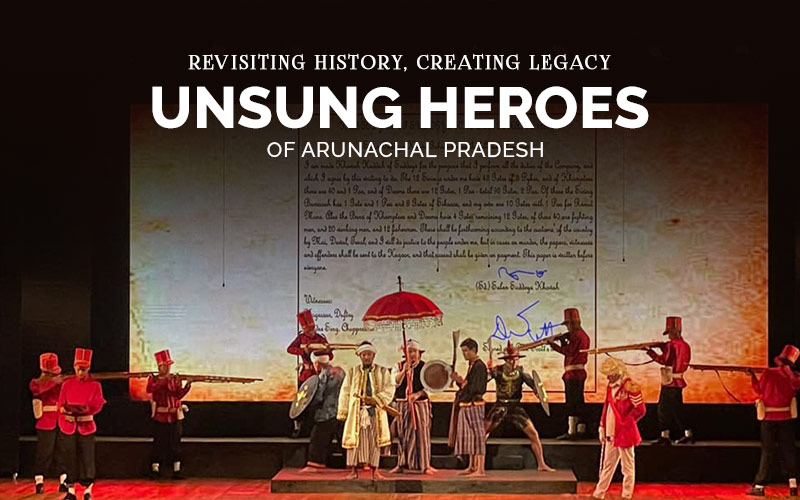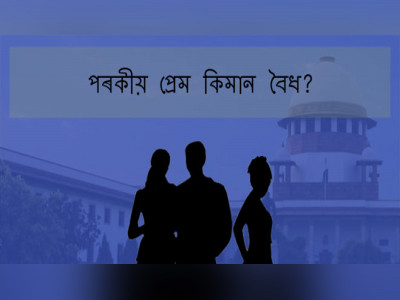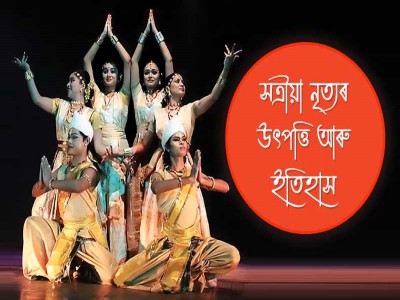
Revisiting History, Creating Legacy: Unsung Heroes of Arunachal Pradesh
Popular history has long ignored the contribution of tribes and
small kingdoms of the Northeast in India’s freedom struggle against the
British. It is also unfortunate that for a long time no historian, individual,
or organization has come up to champion the cause.
Finally, we can see a beacon, through these unprecedented
denials and ignorance. It took a committee of historians, researchers,
and experts from Rajiv Gandhi University (RGU), headed by Deputy Chief Minister
Chowna Mein, who himself is a history buff, nearly two years to compile a
report on the state's 'unsung heroes' and submit it to the state government.
So far, 18 'unsung heroes' have been identified, along with
another 100 freedom fighters, as well as 64 martyrs from tribal communities
from Arunachal who fought against the British.
The Tai Khamti Resistance
– The beginning
The Anglo-Tai Khamti war of 1839 popularly known as ‘The Khamti
Rebellion’ in historical records is one of the first uprisings in the Country;
18 years before the sepoy Mutiny of 1857. It was a very contemplated fight
organized by our Tai Khamti Chief ChauphaPlang Lu alias RonuaGohain (the
warrior or fighter). In 1794 the Tai Khamtis established their rule in Sadiya
after they ousted the Ahom SadiyaKhowaGohain, and assumed its title and rule in
the province. Records of 1830 state that Ronua was a discontented Khamti Chief
and was against the imposition of British rule in Sadiya Province after the
treaty of Yandaboo in 1826. In 1835, more rigorous political and administrative
imposition of Britishers such as the introduction of Panchayat, census, removal
of office of SadiyaKhowaGohain, etc. made the Tai Khamtis determined to drive
away the foreigners. In 1837, ChauphaPlang Lu strategized an intelligence
report of the war along with other Tai Khamti warriors. In January 1839,
Colonel Adam White invited Tai Khamti Chief RonuaGohain and others to attend
his durbar (party). Taking the opportunity, RonuaGohain along with other
important leaders of his Chiefdom finalized the strategies of the attack. Up
till then, the Tai Khamti villages of Dirack, Monglong, and Sadia were
intimidated by the war against the foreigners. On 28th January 1839, about 600
warriors stormed the British Cantonment at Sadiya killing Colonel Adam White,
the Political Agent, and 80 other casualties. In the war, ChauphaPlang Lu made
his supreme sacrifice along with other Tai Khamti warriors. But the Tai Khamtis
did not give in, as they continued to resist the British subjugation till 1843.
Challenged by the tough resistance, the Britishers made a plan to divide the
population and relocate them to different places including Narayanpur, Dhemaji,
Lakhimpur, Shunpura, Tengapani, and Dibrugarh.
The War Chronology -
Anglo Abor War 1858 - 1912
BitborMimak (1858) - the 1st Anglo Abor War
The British expedition led by Captain Lowther, marching toward
Kebang village for attacking the Bihias resettled in Sangajan village, led to
the 1st Anglo Abor War. Kebang warriors led by Lomkom Darang fought valiantly,
causing heavy casualties and forcing the Britishers to retreat.
BongalMimal (1859) – the 2nd Anglo Abor War
On 27th February 1859, the British forces attacked Mongku and
Romkang, two Adi villages, starting the second Anglo Abor war. Adi warriors of
Mongku, Romkang, Kebang, and Rottung bravely fought the war causing heavy
casualties. Thereafter, a peace agreement was signed on 5th November 1862
between the British Govt. and the Adi villages.
MijomMimak (1894) – the 3rd Anglo Abor War
Another punitive expedition by the British troops against Damroh
village, the chief village of the PadamAdis, broke the peace agreement of 1862.
The punitive expedition was despatched mainly to avenge the killing of three
sepoys of Bomjir Outpost on the left bank of Dibang (Sikang) river on 27th
November 1893, allegedly carried out by the men of Bomjir, Dambuk, and Siluk.
The 3rd Anglo Abor War, now popularly known among Adis as
MijomMimak, was marked by fierce battles between British forces and gallant Adi
warriors at many places, the most prominent of them took place at Dambuk
village on 20th January 1894 where stiff resistance was offered by Adi fighters
at a strongly built boulder stockade which is said to be 2000 yards long and 10
feet high. However, the stockade was later breached by the much superior
British forces and thereafter they succeeded in burning Bomjir, Dambuk,
Mimesipo, and Siluk villages. Under stiff resistance from the Adi warriors, the
British forces had to retreat, especially after the Adis cut into the ration
supply of the British forces at Bodak.
PojuMimak (1911) - the final Anglo Abor War
The final Anglo Adi wars were marked by the Abor Expeditionary
Force led by Major General Bower, which selectively targeted and burnt the
Kebang group of villages. A historic war spanning four months culminated after
the breach of KekarYagbo, the war fortress built by the Adis. The fall of
Kebang village played a pivotal role in the resistance of the Adis against
British penetration into the Adi territory. Major administrative changes
followed the PojuMimak, including the establishment of Pasighat as an
Administrative Centre for the entire Abor Hills. Fates and whereabouts of
MatmurJamoh, Lomlo Darang, and BapokJerang, whose bold confrontation with the
British forces, remain a mystery today.
‘Ninu 80!’ The
Anglo-Wancho conflict of 1875
The Wanchos are the major indigenous tribes inhabiting the
Patkai Hills of Longding district in Arunachal Pradesh. British interferences
in Wancho villages were met with extreme retaliation, which started sometime
around 1841 and continued till 1875. This compelled the British Govt. to
withdraw their troops and a policy of non-interference was adopted by them.
However, in 1875, Lieutenant Holcombe, Asst. Commissioner of Sibsagar and
Captain W.F. Badgley led an expedition team of 197 men to the Wancho region and
reached Ninu on 1st Feb 1875. Angered by the unwarranted intrusion, the Wanchos
attacked the troop, killing 80 British armies including Holcombe, 51 wounded
and 66 unharmed; while Captain Badgley escaped with fatal injuries. In March
1875, a strong punitive expedition of British troops was sent to the region;
The Wanchos fought back bravely with indigenous warfare gear and techniques,
but the British army overcame the resistance with their advanced warfare skills
and artillery.
Many Wancho villages like Ninu, Nisa, Longkai, Kaimoi, Kamhua,
and Niaunu were burnt down.
The British Army demanded Ponghi who was involved in the war.
But the Chief of Ninu sternly stated without hesitating - “If I give up, on
that day with the Sun let my glory set; and when the moon sets my glory set,
and my name as Raja be forgotten on the face of the earth”. To this day the
Wanchos have the highest regard for their Chiefs who fought against the
Britishers to protect their territory and to avenge the insult inflicted upon
their culture. The institution of Chieftainship still continues to guide the
social life of the Wanchos.
The dawn - The Miri
Mission of 1911-12
This historical episode saw the resilience of the brave warriors of Arunachal Pradesh against the British Raj who attempted to establish an outpost in TaliLongpo (present-day Tali) in a bid to seize the territory. However, the valiant fight put up by the fierce warriors belonging to present-day KraDaadi and Upper Subansiri districts drove away the British mission, and were successful in defending their territories. Some of the unsung heroes of the Miri Mission of 1911-12 were Langha Pooja (Gungli), Rigio Saki, YardaDangpo, YoraNakio, Tate Niangsa, RangpuKiado, and SorangDangpo.
And the heroes…
Psychologists long have studied to understand the limits of
human perceptual and cognitive capabilities that bring out a leader, a warrior
or a champion from within. However, there are no technical conclusions and one
can only say sheer patriotism, and love for the land and its people triggered
these gentlemen (some of them given below) to achieve such extraordinary feats.
Taji Dele
Dele was one of the youngest freedom fighters of the Elope village in Lower Dibang Valley. Known for his well-versed knowledge of the tactical details of guerrilla warfare and involvement in the resistance against the British. Later he joined the essential militia along with Ponge Dele and raid the Dikrang Block House during the Bebejiya-Mishmi expedition. He was arrested in Sadiya and executed in Tezpur jail on 29 January 1917.
Chaupha PlangLu
PlangLu was the Chief of the Tai Khamti tribe of the Namsai district, also known as RonuaGohain. PlangLu worked out the strategies systematically to reprimand the invading British troops by forming four groups and each group in order to attack from all directions. He with his mates successfully invaded Colonel Adam White and his troops in the year 1839 at Sadiya, Assam. Later the British sent punitive retaliatory expeditions against the Tai Khamtis and on 28 January 1839, a huge British Army surrounded him, where he made the supreme sacrifice.
Matmur Jamoh
Jamoh was the Gam of the Yagrung village in the East Siang district, whose fearless attack on the Britishers led to the fourth and final Anglo Abor War in 1911. It was after Dr. Noel Williamson intruded on Adi territory and publicly abused Jamoh in 1908, that he planned an attack in 1911 during a later visit. Capable Adi warriors like LotiangTaloh, PopiomJamoh, Lomlo Darang, BapakJerang, and LunrungTamuk joined him, resulting in fatal consequences for the Britishers. Thereafter, Jamoh and the other Adi warriors fought gallantly in the final Anglo Abor War, before the British captured him. His life in imprisonment and death is still not known.
Khunjing Wangham
Hailing from Ninu (Nginu) village (Longding district) in Arunachal Pradesh, Wangham was the paramount Chief, known popularly as Nibang. On February 2, 1875, he attacked the British camp at Sumjanuk, which was under the supervision of the Assistant Commissioner at Sibsagar District, Assam, Lieutenant Holocombe. He was a fearless warrior, who refused to give in to British demands and also resisted two successive punitive expeditions against the Wanchos.
Medhi Raja
Raja was an important figure in the history of the Aka community who became a prominent leader sometime after 1873. He was a formidable warrior with a sharp mind and was known to rebel against foreign invaders for the security and interest of the Akas. Raja fought the important Anglo-Aka War of 1883-1884 with valor and courage, before his submission to the Britishers on Jan 21, 1884.
Wangchin Wangsapa
Wangsapa of Ninu (Nginu) village (Longding District) played a
critical role in the governance of the Chief of Ninu’s council. On February 2,
1875, he led hundreds of Wanchos into the camp of the British expedition team
at Sumjanuk of Ninu village to drive out the Britishers from their land. He was
the first person to lead the attack and defeated the British
army. Wangsapa also prepared the Wancho warriors to fight against the
successive British Punitive expeditions in March 1875 and April 1876.
Tagi Raja
Raja, the successor of Aka Chief Pario, was acknowledged as a
Raja by the Ahom Ruler. He was an extraordinary leader who led several raids on
the British forces in the region of Assam. He was arrested by the British and
suffered incarceration for several years. Nevertheless, he did not surrender
even after his release from prison and continued to raid the British troops
from 1832 until 1842
Moje Riba
Riba was born in Dari village in Lepa Rada district
(present-day) and was lovingly called AbohNyiji. He was a prominent martyr of
the freedom movement. He was arrested by Britishers in 1947 for campaigning for
the freedom movement. He was the first person from Arunachal Pradesh to hoist
the national flag at Dipa Village in Arunachal Pradesh on August 15, 1947. He
was also awarded TAMRA PATRA in 1974 at Shillong.
Chow Tewa
Tewa, also known as Towa Gohain, was the Tai Khamti Chief of the
Dirak region of the Namsai district. He fought fearlessly in the Tai
Khamti-Anglo war of 1839. He was the one who led the Tai Khamti warriors to
attack the British Cantonment at Sadiya on 28 January 1839 and fought bravely
against the successive punitive expeditions of the British Army for several
years. At last, he made his supreme sacrifice while fighting against the
British troops.
Ponge Dele
Dele was a great leader of the Elope village in the Lower Dibang
Valley District. He was a skilled strategist and had a great role in the
Bebejiya-Mishmi Expedition. In the First Bebejiya-Mishmi Expedition, he was
arrested alongside Ekhroma Dele and Malu Mimi and later released on May 16,
1900. Dele led a group of warriors to raid the British troops in Sadiya and
succeeded in invading them. He was martyred on the battlefield during the third
Bebejiya-Mishmi Expedition.
Ningroo Thumung
Thumung was a prominent leader of the Ningroo Gaum, born in the
NingrooKawng (also known as Manmomukh) in the Changlang district. In the year
1828, NingrooThumung gathered hundreds of Singpho fighting men and declared war
against the British Government. During his fight against the British Army,
Ningroo was captured and sentenced to death for treason against the British
Government in Calcutta. Ningroo is considered one of the bravest heroes in the
Singphos community, having fought against the British Army to protect his
motherland.
Beesa Gaum
Gaum was the chief of the Singphos who took an active part
during the revolt of 1843 against the British. On 10 January 1843, the
Singphos, under the leadership of Gaum, successfully invaded the British in
Beesa Post and took control of it. After fighting several battles against the
British, Gaum was finally captured by the army and brought to trial in court.
The court ordered the confiscation of his property, and he was imprisoned for
life at Dibrugarh Jail.
Ligin Bomjen
Bomjen was the son of ChabliBomjen, born in March 1926 at Bagra
village in West Siang District, Arunachal Pradesh. He also held the post of
office secretary for the Dipa Congress Committee formed at Dipa village. He
also defied British officials' orders to recruit porters from villages where
the British had banned the salt trade and managed to smuggle salt into his
village and awarded the TAMRA PATRA on January 26, 1989, for his
participation in India's freedom movement.
Bom Singpho
Singpho was a prominent member of Beesa Gaum who joined with
some of the Ahom nobles to overthrow the British rule from their motherland. On
25 March 1830, Singpho and a rebel group of 400 men attacked the British
Army, who were guarding the armory depot at Rangpur, Assam. However, they could
not withstand the artillery power of the British troops and retreated into the
jungle. Later, Bom, along with other captured leaders, was sent to Decca
(Dhaka) Jail.
Langha Poja (Gungli)
Poja (Gungli) was the eldest son of LanghaTapo of Langha Village
under the present-day Tali Administrative Circle of KraDaadi District. Since an
early age, Poja (Gungli) has been ready to take on any challenges to
defend his family and society. He was an active member in the Miri War of
1911-12 who led an attack on the British Army when they were trying to set up
an outpost in the TaliLongpo region and protected his territory. Poja
(Gungli) laid down his life while attempting another attack on the British
Army.
Tana Nanna
Nanna was one of the leading orators and experts in
traditional jurisprudence and a powerful Nyub (supernaturally ordained priest)
of Nujuk Village in Papum Pare district. He was also one of the richest men in
the area, having built several traditional rest houses in the foothills of the
area. When the British destroyed some of his traditional rest houses built on
the plain, Nanna organised an attack on the British territory to take revenge.
In the aftermath of this attack, the British launched a massive military
expedition against Tana Nanna in 1874.
Techi Gubin
Gubin was one of the leading village elders of Luchung village
in PakkeKessang district. Gubin disliked the British officials, whom he saw as
a threat to his authority in the foothills and interfering with the Poza
collection. After the Treaty of Yandaboo in 1826, the British started meddling
in the affairs of hill tribal chiefs. Looking into this, he gathered hundreds
of fighters and became an ally of the Tana Nanna in fighting against the
British at AmtolahGubin fought bravely with Tana Nanna in the Amtolah Conflict
of 1873 and defended their territory against the British.
Moji Riba
Riba was the one who opposed the Britishers' mistreatment and
discrimination against Galo people in development activities and trading rights
in Assam and led the Dipa Congress Committee as president and joined India’s
freedom movement. He was also awarded the TAMRA PATRA in 1974 at Shillong
by K. A. A. Raja, then Chief Commissioner of Assam, for his participation in
the freedom movement.
The contribution from the tribes and these individuals along
with many others whose legacy probably has become parable has actually founded
India’s freedom struggle and eventually our freedom. My salute and obeisance
to all the unsung heroes.
Disclaimer: The opinions expressed in this article are those of the author's. They do not purport to reflect the opinions or views of The Critical Script or its editor.

Newsletter!!!
Subscribe to our weekly Newsletter and stay tuned.

















Related Comments